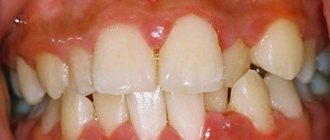Chronic tonsillitis is a disease of the palatine tonsils, which is characterized by exacerbations and periods of remission, the duration of which largely depends on the state of the patient’s immune system, as well as on the adequacy of therapy. The symptoms of chronic tonsillitis are vague, and therefore patients cannot independently diagnose the presence of this disease. If you feel even the slightest discomfort in your throat, this is a reason to immediately consult a doctor for advice. Timely conservative treatment will help avoid surgery and numerous systemic complications.
Description and symptoms of chronic tonsillitis
Chronic tonsillitis occupies a leading place among inflammatory diseases of the throat. Throat diseases reduce the quality of life and lead to complications. Chronic inflammation of the tonsils is often observed in children starting from 3 years of age and in young people.
Types of tonsillitis
- Acute tonsillitis (tonsillitis) is an infectious disease with local manifestations of acute inflammation of the components of the lymphatic pharyngeal ring, most often the palatine tonsils, which is caused by streptococci or staphylococci, less often by other microorganisms.
- Chronic tonsillitis is a long-term inflammation of the pharyngeal and palatine tonsils. Develops after a sore throat and other infectious diseases accompanied by inflammation of the mucous membrane of the pharynx (scarlet fever, measles, diphtheria), or without a previous acute illness.
There are two stages. Compensated and decompensated stages:
- The compensated stage is a dormant focus of infection. There is no visible reaction from the whole body, no repeated sore throats. The barrier function of the tonsils and the reactivity of the body are not impaired. The edges of the palatine arches thicken, cicatricial adhesions appear between the tonsils, plugs form in the lacunae of the tonsils, liquid purulent discharge forms, and the submandibular and cervical lymph nodes enlarge. One of the problems of the compensated form of tonsillitis is bad breath, which occurs as a result of the formation of plugs in the lacunae.
- During decompensation, frequent sore throats are a concern; complications of tonsillitis in the form of abscesses, inflammatory diseases of the ear and sinuses, as well as damage to other organs (heart, kidneys) are often observed. Exacerbation of chronic tonsillitis is also called tonsillitis.
Symptoms of chronic tonsillitis
- discomfort and pain when swallowing, especially in the morning;
- dryness, sore throat; sensation of a foreign body in the throat
- cough;
- bad breath;
- increased fatigue, weakness and sweating;
- decreased performance;
- low-grade fever 37.2-37.5°C
- deterioration of sleep;
- decreased appetite;
- pain in the cervical lymph nodes.
Causes that can lead to chronic tonsillitis
The following factors have a particularly strong influence on the chronicity of the process:
- Frequent sore throats, especially in the absence of adequate treatment;
- Impaired nasal breathing, which can be a consequence of both a deviated nasal septum and chronic rhinitis and sinusitis. If rhinitis is of an allergic nature, then it is advisable to do an allergen test and undergo appropriate treatment;
- Low body immunity.
Chronic tonsillitis develops due to a number of factors
- Intoxication - due to the absorption of bacterial toxins and products of chronic inflammation in the tonsils. Intoxication explains symptoms of chronic tonsillitis such as fatigue, weakness, headache, low-grade body temperature, etc.
- The formation of plugs in the tonsils irritates the nerve endings and causes moderate pain in the throat and heart area, cough, and bad breath. Nerve endings undergo degenerative changes, which can cause neurosis and other disorders of the nervous system.
- The body develops sensitivity to bacterial and tissue antigens - an allergy develops. Therefore, chronic tonsillitis is also of an autoimmune nature.
Chronic tonsillitis with complications can lead to functional disorders of cardiac activity, acquired heart defects. Chronic tonsillitis is associated with pathologies such as rheumatism, infectious arthritis, diseases of the urinary system, prostate gland, meninges, etc.
Features of the disease in children
Intensive development of the lymphoid ring begins in infancy - in the second year of life. Immediately after birth, the tonsils are underdeveloped and do not yet function fully. A feature of the tonsils in children 1-3 years old is deep lacunae, as well as narrow, densely branching orifices, which can extend to the capsule. Sometimes the lacunae turn sharply and extend under the integumentary epithelium instead of going deep into the tonsils. At the end of narrow passages there are characteristic expansions that contribute to the development of the inflammatory process.
A feature of younger age is hypertrophy of lymphoid tissue, which, along with an increase in the number of lymphoid follicles, leads to the growth of tonsils. The latter reach their largest size by 5-7 years. At this age, children are most susceptible to infectious diseases and most need protection from infections. Representatives of this age category are recommended to receive preventive vaccinations aimed at mobilizing lymphoid tissue to develop immunity.
The cause of hypertrophy of lymphoid tissue is the intensive formation of active immunity, which is accompanied by local production of antibodies in response to the penetration of an infectious agent. With age, by the age of 9-10, antibodies accumulate in the body, the immune system improves, which leads to age-related involution of lymphoid tissue. Part of it degenerates and is replaced by connective or fibrous.
The causes of childhood respiratory diseases are fungi, bacteria and viruses. If a child gets sick too often, the tonsils are regularly attacked, so the body does not have time to fully defend itself. This becomes the main reason for the development of chronic tonsillitis, along with incorrectly prescribed antibiotic treatment.
Chronic tonsillitis in a child turns into a constant source of infection, depleting the immune system. Quite often, the disease leads to serious complications, especially if timely help is not sought.
Symptoms
Unlike adults, in children the disease develops quickly, occurs in an acute form and is quite obvious. An obvious indication of chronic tonsillitis may be the following local reactions:
- redness of the tonsils;
- their increase, looseness;
- purulent discharge;
- enlarged cervical lymph nodes.
Frequent sore throats, bad breath, and discomfort during swallowing may also indicate the chronic nature of tonsillitis. Some patients experience sleep problems, headaches, and a subfertile temperature (37-37.5 °C).
Chronic tonsillitis in a pregnant woman
Symptoms of the disease in a pregnant woman are fever, general weakness, dry cough, sore throat, which is accompanied by a sensation of a foreign body. This is due to the fact that the tonsils withstand the attack of tonsillitis and respond to it with pain.
Not everyone knows that even a mild sore throat can harm the unborn child, as well as the woman herself. Sometimes the disease causes early miscarriage, and sometimes causes the development of late toxicosis, which negatively affects the development of the fetus. Since the presence of a chronic infection in the body weakens the immune system, a pregnant woman is at risk of developing other diseases.
Clinical studies have confirmed that chronic tonsillitis has repeatedly caused poor labor and premature birth, so women with this diagnosis are often recommended to have a cesarean section. Sometimes a disease that is not treated during pregnancy leads to the development of a heart defect in the child.
Causes of chronic tonsillitis in pregnant women
- sore throat, which has become a latent chronic form;
- hypothermia;
- deficiency of vitamins and nutrients;
- weakened immunity;
- problems with nasal breathing caused, for example, by a deviated nasal septum, polyps or adenoids;
- untreated caries;
- sinusitis.
To avoid undesirable developments, pregnant women are advised to eat well, avoid hypothermia, visit the dentist and generally monitor their health.
Why is chronic tonsillitis dangerous?
Regardless of the form of its occurrence, chronic tonsillitis can cause allergization and infection of the body. In the absence of medical control, the disease can lead to serious complications - frequent exacerbations in the form of a sore throat, recurring up to 6 times a year.
Another serious complication is phlegmon of the neck, which occurs against the background of severe forms of peritonsillar abscess. In addition, weakening of the tonsils leads to the penetration of infection into the underlying respiratory tract and the development of pharyngitis and bronchitis. In general, chronic tonsillitis either itself becomes a source of concomitant diseases or complicates their course.
An infection that has entered the body finds “weak” spots and can cause diseases of any of the systems - bronchopulmonary, urinary, cardiovascular. A chronic focus of infection has a negative effect on the blood coagulation system, metabolic and endocrine processes, the adrenal cortex, and the course of allergic conditions. Inflammation of the palatine tonsils causes epileptic attacks and aggravates the course of encephalitis and cerebral rheumatic vasculitis. The most dangerous is the decompensated form, which provokes changes in internal organs.
Consequences of chronic tonsillitis
- The disease in a certain way affects the course of collagen diseases - rheumatism, systemic lupus erythematosus, scleroderma, polyarthritis, dermatomyositis, periarthritis nodosa.
- The cause of frequent sore throats is heart disease - arrhythmias, endocarditis, myocarditis, acquired defects. Since there is a close connection between the lymphatic system of the heart and the ducts of the tonsils, even people under the age of 30 are diagnosed with cardialgia.
- Chronic intoxication has an adverse effect on blood vessels, especially capillaries. Patients complain of increased fatigue, weather sensitivity, headaches including migraines, and dizziness (Meniere's syndrome).
- The consequence of the chronic form of tonsillitis can also be diseases of the gastrointestinal tract - gastritis, colitis, duodenitis, stomach and duodenal ulcers.
- Against the background of chronic tonsillitis, skin pathologies and diseases of the subcutaneous fatty tissue often develop - psoriasis, neurodermatitis, acne, microbial eczema, atopic dermatitis, polymorphic exudative erythema. It makes no sense to treat them until the source of infection is eliminated.
- Chronic tonsillitis often causes lung diseases - bronchial asthma and chronic bronchitis, and also contributes to the exacerbation of chronic pneumonia. According to pulmonologists, the number of complications with such diagnoses can be reduced by 2-3 times if the source of infection is carried out in a timely manner.
- The disease also has a negative effect on the accommodative apparatus of the eye. Early sanitation can, according to ophthalmologists, prevent the development of myopia, as well as prevent relapses of conjunctivitis and blepharitis.
- The liver and the biliary system are also targeted by infection: cholecystitis, cholangitis and cholangiocholecystitis develop against the background of tonsillitis.
- Weakening of the functions of the pancreas due to focal infection in the tonsils contributes to the formation of diabetes mellitus. The thyroid gland also suffers, and its hormone-forming function is disrupted (thyrotoxicosis).
- Against the background of tonsillitis, there are disorders in the reproductive sphere: potency in men decreases, and in women of childbearing age, uterine bleeding, endometriosis, uterine fibroids, hypomenstrual syndrome and infertility are observed. Cases of pathological pregnancy - threats of miscarriage and premature birth - are not uncommon.
- Another serious consequence is kidney damage (pyelonephritis, glomerulonephritis, nephritis, etc.).
What other tonsils are there in the pharynx?
Other tonsils that form the lymphoid pharyngeal ring are: adenoid vegetations, or, more simply, adenoids, which are not a paired organ. They are located in the dome of the nasopharynx. It is impossible to see them with the naked eye. In order to recognize the condition of the adenoids, it is necessary to perform an endoscopic examination of the nasopharynx. Inflammation of the adenoids is called adenoiditis and is more common in children.
Also in the pharynx there is a lingual tonsil, located at the root of the tongue, which, like the adenoids, is an unpaired organ.
There are also tubal ridges, which are also called tubal tonsils. They are located at the entrance to the pharyngeal mouth of the auditory tube. The tube ridges are located deep in the nasopharynx, on the lateral (medial) surfaces of the nasopharynx on the right and left. Tubal tonsils perform an important function - they protect against infection entering the auditory tube. Since each of the tonsils of the lymphoepithelial pharyngeal ring deserves separate close attention, in this article we will only talk about the palatine tonsils and chronic tonsillitis. Other tonsils and the pathology they cause will be described in detail separately, in other relevant ENT articles.
Diagnosis of chronic tonsillitis
Diagnostic measures begin with an examination of the patient by a doctor who is interested in the appearance of the tonsils, as well as the presence of purulent or other contents in the lacunae. If this is detected, then it is necessary to conduct a bacteriological analysis of the discharge, followed by testing for sensitivity to antibiotics. A similar procedure is performed even if surgical removal of the tonsils is indicated to prevent postoperative infectious complications.
Often diagnostic measures include consultation with a cardiologist, nephrologist and so-called rheumatic tests. This allows you to determine how far the process has gone and whether there is systemic autoimmune damage to the target organs, such as the heart, kidneys and joints.
If there are indications for surgical removal of the tonsils, the patient must undergo additional examination, which includes:
- Blood test for hepatitis and HIV infection;
- Blood sugar test, since diabetes mellitus is a contraindication to such an operation;
- Cardiogram;
- Consultation with a therapist.
Classification B.S. Preobrazhensky
| Form of the inflammatory process | Distinctive manifestations |
| Simple (uncomplicated) form | Only local signs are present: Pus and dense plugs from it, closing the lumen of the lacunae, and the inflamed surface of the tonsils (they are loose, red, swollen). Inflamed edges of the arches of the palate (they are swollen, red, infiltrated). |
| Toxic-allergic tonsillitis 1st degree | Local manifestations of an uncomplicated form are superimposed by general symptoms of an allergic-toxic nature: Periodic low-grade fever (temperature readings up to 37.5°C). Tonsillogenic intoxication, present constantly or periodically - decreased performance, fatigue, poor appetite, general weakness, malaise, feeling of weakness throughout the body. Enlargement of the lymph nodes of the neck, their soreness. Periodically appearing joint pain. Changes in blood tests - increased leukocytes, accelerated ESR. |
| Toxic-allergic tonsillitis 2nd degree | Signs of the 1st degree are accompanied by severe manifestations of a toxic-allergic nature: Functional ECG changes. Heart pain. Heart rhythm disturbances. Long-lasting low-grade fever. Development of autoimmune complications of tonsillitis. |
Treatment of chronic tonsillitis
Treatment of chronic tonsillitis is traditionally carried out in two directions.
Conservative treatment
This therapy is relevant if pathological changes in the tonsils are compensated. This treatment effectively combines pharmacotherapy with physiotherapeutic methods and pursues the following goals:
- Physical elimination of infection from the surface of the tonsils;
- Relieving swelling and reducing the size of the tonsils;
- Elimination of symptoms of an allergic nature;
- Increasing local immunity, including through the inclusion of the tonsils themselves in the work.
Conservative treatment includes:
- Sanitation of the tonsils using ultrasound, which ensures a deep degree of cleaning of the lymphoid tissue;
- Anti-inflammatory laser therapy;
- Irrigation of the oral cavity with special medicinal solutions that increase local immunity and have bactericidal properties;
- Pharmacotherapy.
Surgical treatment involves complete or partial removal of lymphoid tissue, which can be carried out either traditionally or using a laser. Tonsillectomy has a significant list of contraindications, so the attitude of doctors towards it in recent years has been more wary than in previous decades.
Treatment of chronic tonsillitis in a child
Proper treatment of sore throat in most cases leads to a successful cure, while ignoring symptoms or incorrect actions can lead to the disease becoming chronic. In this case, exacerbations are possible almost once a month.
The treatment regimen for chronic tonsillitis in a child depends on the course of the disease and can be completely different, especially for periods of exacerbations and remission. In a state of remission, it is important to extend this period as long as possible, for which purpose anti-relapse therapy is prescribed at least twice a year, taking into account the individual characteristics of the patient.
General treatment includes non-sedating antihistamines, immunomodulators, vitamin therapy and homeopathy. Local methods include massaging the tonsils, washing the lacunae with medications, rinsing with antiseptics and treating the tonsils with agents that have antiseptic, anti-inflammatory and regenerating properties.
Physiotherapeutic methods are aimed at improving microcirculation in the tissues of the tonsils. These include:
- microwave therapy;
- ultrasound;
- laser therapy;
- Microwave and UHF;
- inductothermy;
- magnetic therapy;
- electrophoresis;
- inhalation;
- ultraviolet irradiation of the tonsils;
- mud therapy, etc.
If the disease has entered a protracted form, the approach to treatment changes radically - bacteriophages are used. We are talking about viruses that destroy streptococci and staphylococci as the main causative agents of the disease. This method has shown excellent results in the treatment of infections of the oral cavity and nasopharynx, which are accompanied by frequent relapses.
Home methods for treating chronic tonsillitis are allowed only under the supervision of a doctor. These include:
- ingestion of herbal tea from medicinal plants - St. John's wort, peony, calendula, chamomile, dill, coltsfoot, thyme, sage, eucalyptus, etc.;
- gargling with the above herbs;
- ingestion of propolis with honey.
Only regular treatment for two years can achieve positive dynamics. If exacerbations have not been observed for five years in a row, they speak of improvement. Compliance with all instructions often leads to a decrease in the number of relapses, however, if this result cannot be obtained, extreme measures are resorted to - tonsillectomy, or complete removal of the tonsils. Surgery has a number of contraindications.
Prevention of chronic tonsillitis
In order to prevent exacerbations, the tonsils need not only protection from adverse factors, but also hardening. To do this, doctors recommend periodically eating ice cream and drinking cold drinks in small portions - only during the period when the person is completely healthy.
It is important to eliminate all factors that can cause a sore throat, that is, take care in advance of the treatment of the nose and oral cavity, as well as the free breathing of the child. Rinsing with antiseptic agents helps clear the tonsils of bacteria. It is useful to gargle twice a day after meals with a solution of furatsilin, a decoction of sage, chamomile or calendula. The course is carried out for a month, then take a break.
Another effective remedy is tonsil massage. Perform it before going outside and before eating cold food. The procedure consists of light stroking in the area under the chin in the direction from the jaw to the chest. If the disease has become protracted, treatment should be more intensive.
Tonsillitis is a rather dangerous disease that can haunt a person throughout his life from early childhood and cause the most unexpected complications. Therefore, it is so important not to let the disease take its course, but to seek help in time.
Forms of the disease
- recurrent form, that is, with frequently recurring sore throats;
- protracted form, when the inflammatory process in the palatine tonsils is characterized by a sluggish and prolonged course;
- compensated form, when episodes of sore throat and exacerbation of tonsillitis are not observed for a long time.
Chronic tonsillitis is the most common disease among all diseases of the pharynx and one of the most common diseases of all ENT organs, along with such a diagnosis as acute sinusitis.
Chronic tonsillitis can affect both adults and children, from the moment the palatine tonsils begin to develop (from 2-3 years). Moreover, the incidence of this disease in childhood is much higher.
Some respiratory diseases can also be classified as social diseases. For example, sinusitis and tonsillitis are among them. Poor environment, stress, lack of sleep, overwork, monotonous and poor nutrition, as well as poor heredity are predisposing factors to the development of the disease.
Causes
The development of the disease is closely related to frequent sore throats (acute tonsillitis). Very often, incompletely cured tonsillitis leads to chronic tonsillitis. Very often, tonsillitis is an exacerbation due to the accumulation of plugs in the tonsils - caseous-necrotic masses, which are often confused with food debris.
Main reasons for development
- Unfavorable working conditions. The greatest influence is exerted by gas and dust levels in the air at work.
- Poor environmental conditions, pollution from vehicle exhaust gases, harmful emissions into the atmosphere.
- Low quality of consumed water.
- Weak (low) immunity.
- Severe hypothermia of the body.
- Stressful situations.
- The presence of chronic diseases in the nasal cavity, paranasal sinuses and oral cavity - dental caries, purulent sinusitis, etc., which often leads to infection of the tonsils.
- Irrational or poor nutrition, in which excess amounts of proteins and carbohydrates are consumed.
- Heredity (mother or father suffers from chronic tonsillitis). It is very important for a woman to undergo one or two courses of treatment for tonsillitis during pregnancy (depending on the severity of the process) in order to minimize the likelihood of the disease developing in the unborn child.
- Frequent overwork, fatigue syndrome, inability to fully rest.
- Smoking and alcohol abuse.
Surgical removal of tonsils
If we talk about the removal of the tonsils, then the operation to completely remove the tonsil tissue is called a bilateral tonsillectomy.
Partial removal of the tonsils is called a bilateral tonsillotomy.
It is extremely rare that the palatine tonsil is removed routinely on one side. There is also a practice of a number of hospitals (they like to do this in the Pirogov City Clinical Hospital No. 1) of removing the palatine tonsil or tonsils in case of a paratosillar abscess. This operation is called abscessonsillectomy. But it must be remembered that against the background of severe pain caused by an abscess, removal of the tonsil is extremely painful. Due to the purulent process, it is impossible to provide adequate anesthesia. Therefore, it is necessary to anesthetize the peri-almond tissue only with strong anesthetics: Ultracaine and Ultracaine DS-forte.
Routinely, palatine tonsils can be removed under local anesthesia or general anesthesia. Previously, this operation was performed only under local anesthesia.
Fortunately, there is now modern equipment that allows removal of palatine tonsils under general anesthesia or under anesthesia using cold plasma coagulation - Coblator.









